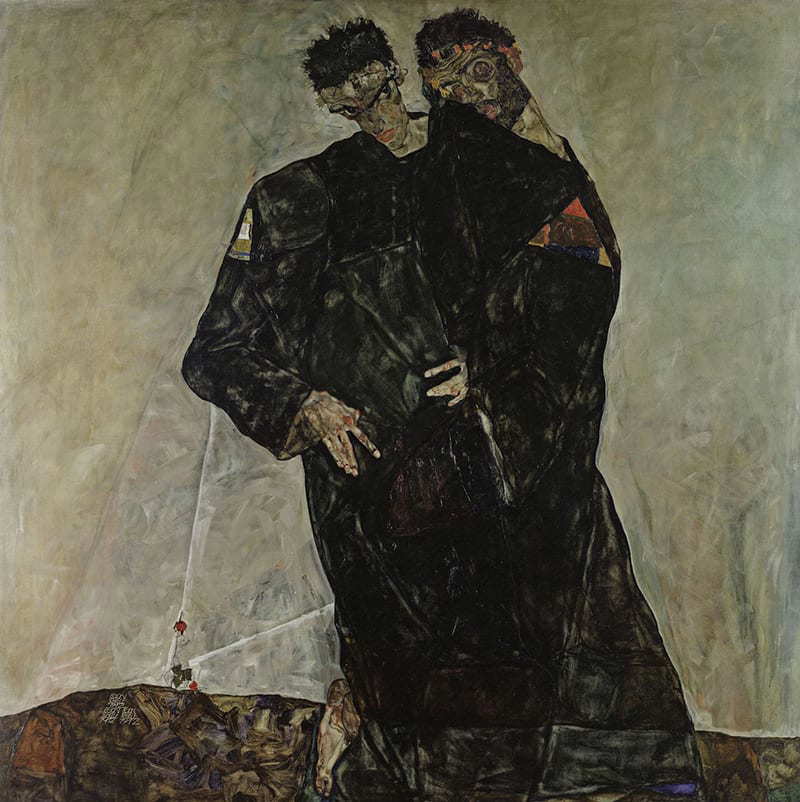
Egon Schiele was an important representative of Austrian expressionism. Although the artist had a very short life and career – Schiele died at the age of 28 – his oeuvre was extensive.
Within only ten years, Schiele painted about 330 oil paintings and finished thousands of drawings. His work is known for his intensity and for showing raw sexuality. Egon Schiele mainly produced figurative paintings as well as a large number of self-portraits.
In the following, we’ll describe some other important facts about Egon Schiele:

5. Lost his father at the age of 14
Egon Schiele was born in 1890 in Tulln, Austria. His father Adolf Schiele was the station master of the Tulln station. As a child, he was obsessed with trains and filled sketchbooks with drawings of trains – until his father had enough of all the drawing and destroyed his son’s work.
When Adolf Schiele died of syphilis, Egon was only 14 years old. The artist is said to have never really recovered from the loss. Years later, he described his pain in a letter to his brother: “I don’t know whether there is anyone else at all who remembers my noble father with such sadness.” In the letter, he also explained: “I don’t know who is able to understand why I visit those places where my father used to be and where I can feel the pain … Why do I paint graves and many similar things? Because this continues to live in me.”

4. A protégé of the artist Gustav Klimt
At the age of 16, Schiele moved to Vienna to study at the Academy of Fine Arts. One year later, the young art student, got to know Gustav Klimt, whom he admired and who should become his most important mentor throughout his whole career.
Klimt invited Egon Schiele to exhibit his work at the Vienna Kunstschau in 1909. There, Schiele also encountered the work of artists like Edvard Munch and Vincent van Gogh.

In his early years, Schiele was influenced a lot by Gustav Klimt and also by another Austrian expressionist: Oskar Kokoschka. Some elements of these artist’s styles can be found in many of Schiele’s early works as these examples show:


After Schiele had left the Academy of Fine Arts in 1909, he with his new won freedom more and more evolved his own style. In this time, Egon Schiele developed a style dominated by nudity, erotism and what is often called figurative distortions.

3. Gustav Klimt and Wally Neuzil lived in a love triangle
Gustav Klimt introduced the 20 years younger Egon Schiele to a lot of other artists, many gallerists as well as to his models. One of them was Wally Neuzil, who is rumoured to have been also Klimt’s mistress. In 1911 though, Wally Neuzil and Egon Schiele moved to Krumau in the Czech Republic.
Get the latest articles delivered to your inbox
Sign up to our Free Weekly NewsletterThe two there had an affair that lasted four years, until Wally in 1916 obviously had enough of that and moved back to her older lover, Gustav Klimt.

Egon Schiele alludes to this love triangle in his painting “The hermits” which shows Schiele and Klimt, dressed all in black, standing entwined. The red elements in the painting are said to allude to Wally Neuzil’s red hair.

2. 24 days in prison
After Wally Neuzil had gone back to Vienna, Egon Schiele was driven out of town in Krumau by his neighbours. They felt offended by his lifestyle and by seeing a naked model posing in front of the artist’s house.
Egon Schiele decided to move on to the village Neulengbach. However, also the inhabitants of this little Austrian village did not like the artist’s open lifestyle. Schiele’s studio there was said to have been a place where a lot of delinquent juveniles hung out.

In April 1912, Schiele himself was arrested for seducing a young girl. In his studio, the police found hundreds of drawings. A lot of them they considered pornographic. Until his trial began, Schiele stayed imprisoned for 24 days. In the trial, the charges of seduction and abduction were dropped – but the judge found him guilty for exhibiting erotic drawings in front of young children.
1. Died in 1918 – only three years after his pregnant wife
After being imprisoned, he moved back to Vienna, where his friend Gustav Klimt helped him to re-socialize in the art scene. In the following years, Schiele got more and more international attention.
In 1918 his work was exhibited at the Vienna Secession’s 49th annual exhibition. However, with the end of World War I, also the Spanish flu spread all over the world. Neither Schiele and his wife Edith could escape from becoming infected.

On October 28, 1918, Edith Schiele died six months pregnant. Egon Schiele died only three days later, on October 31 at the age of 28.






